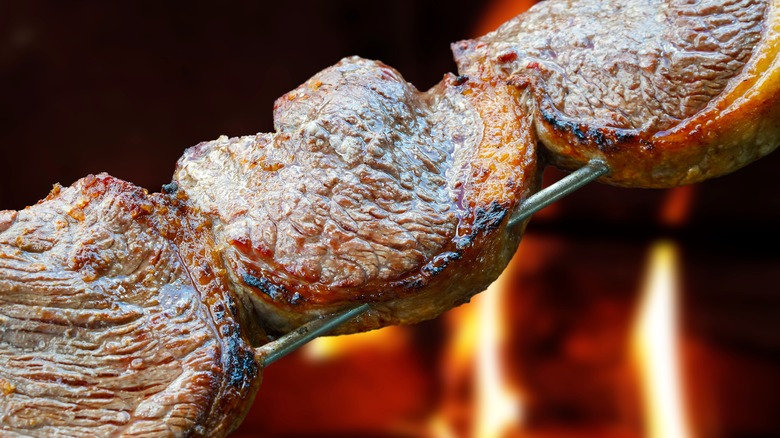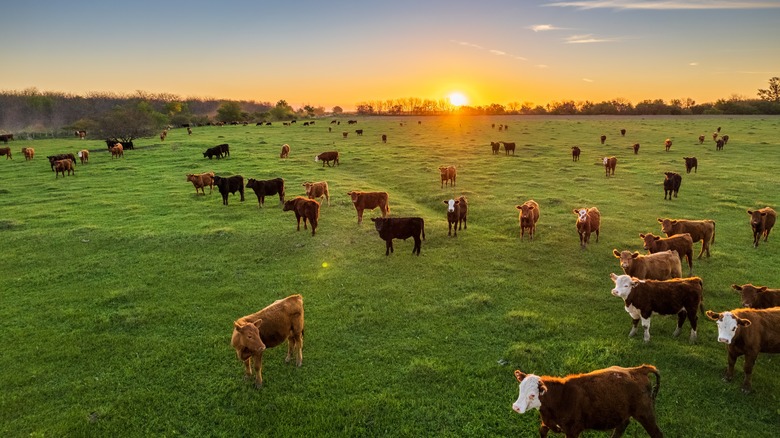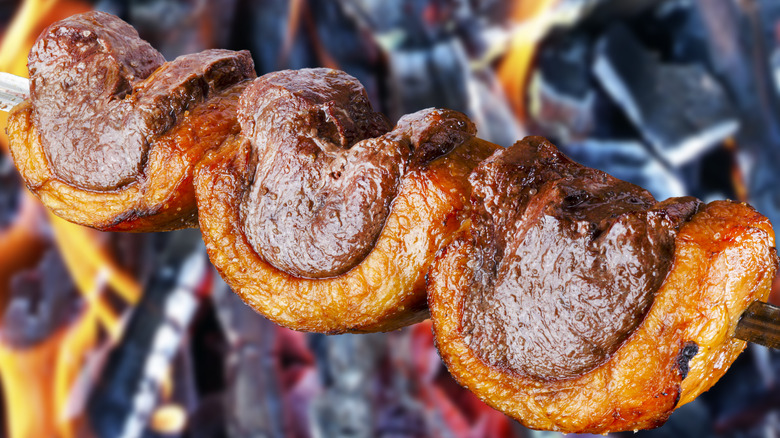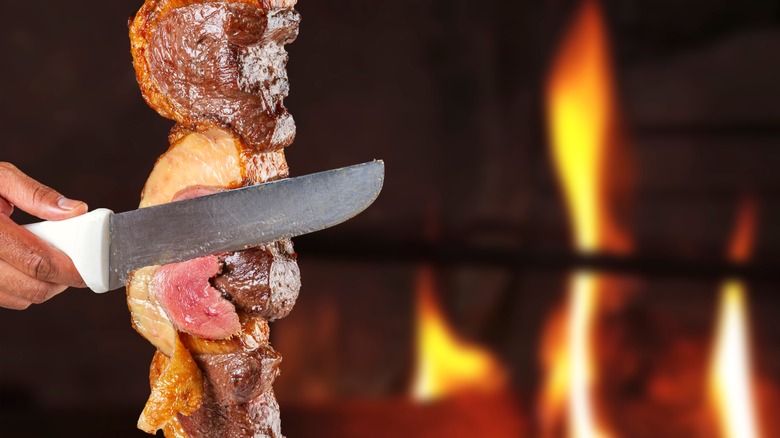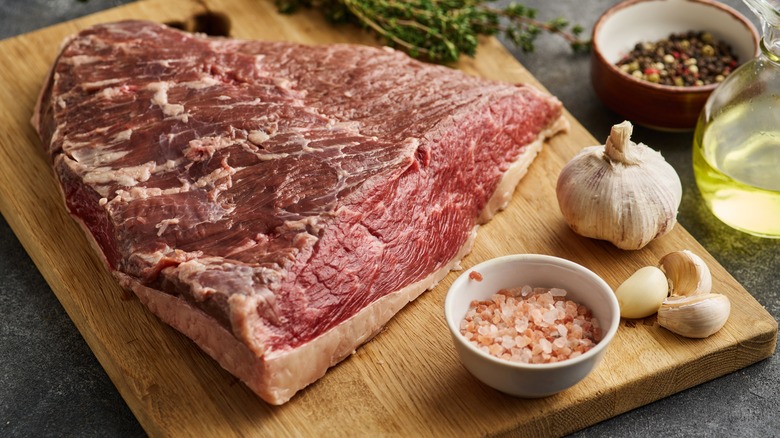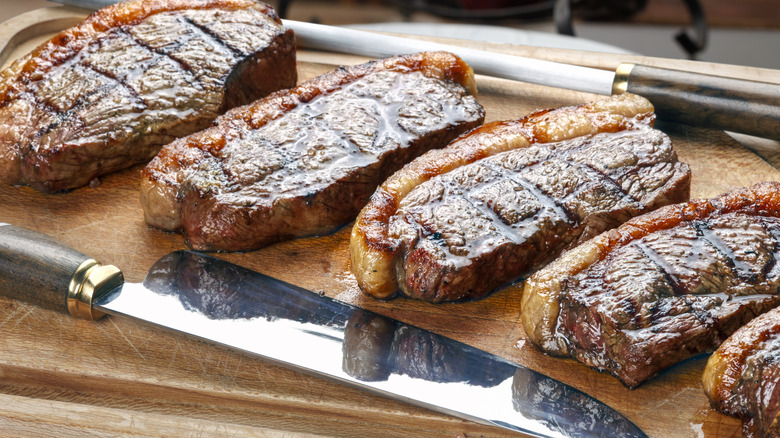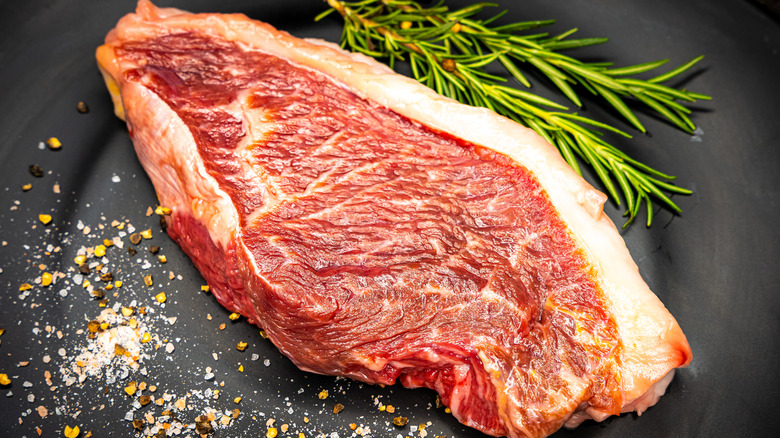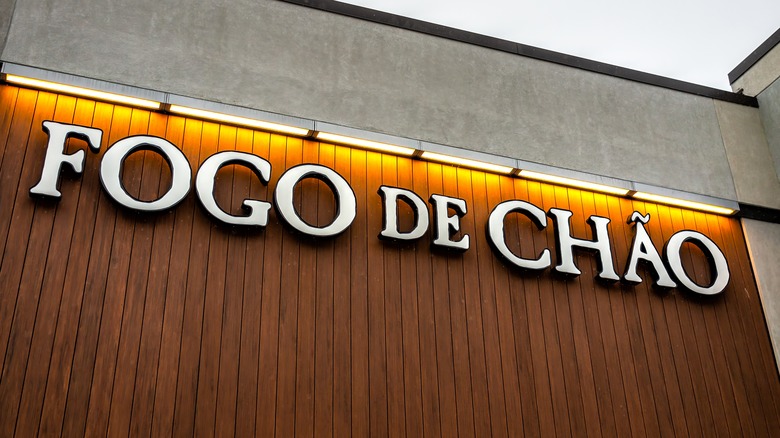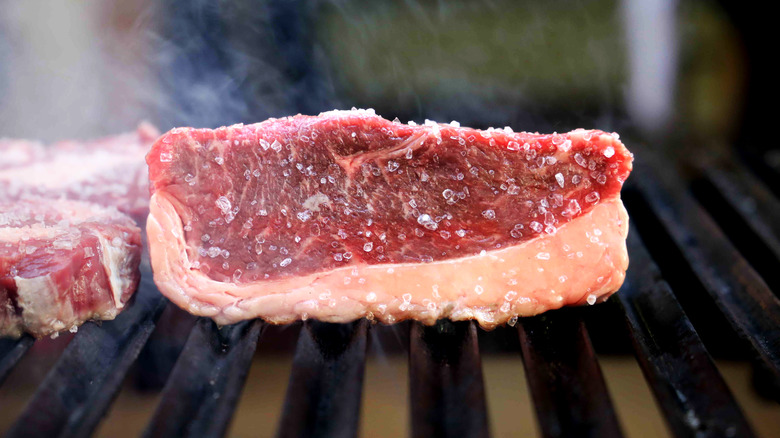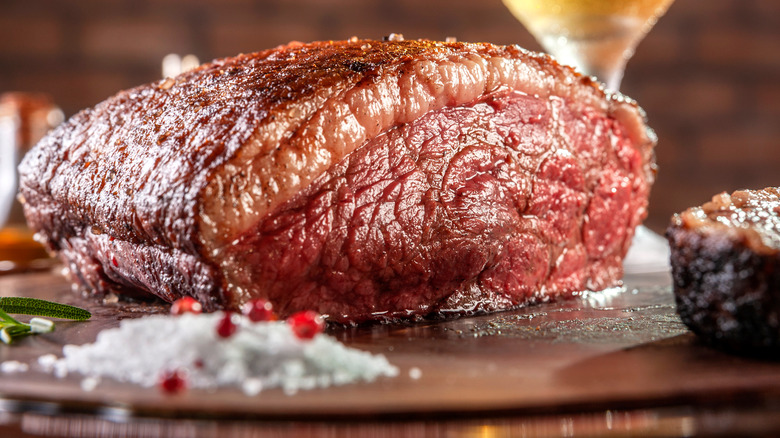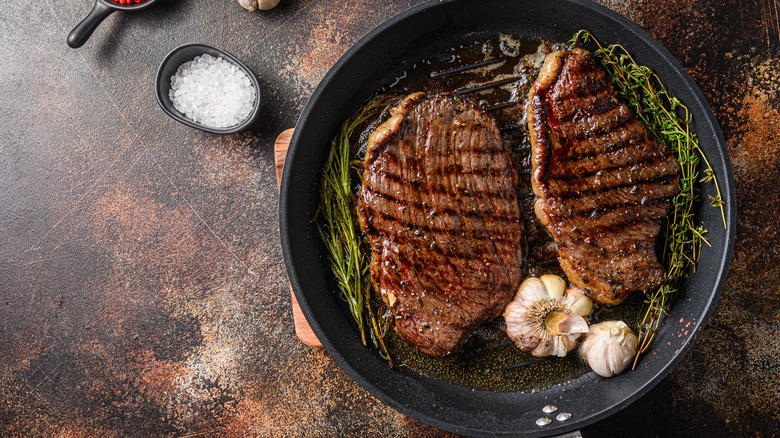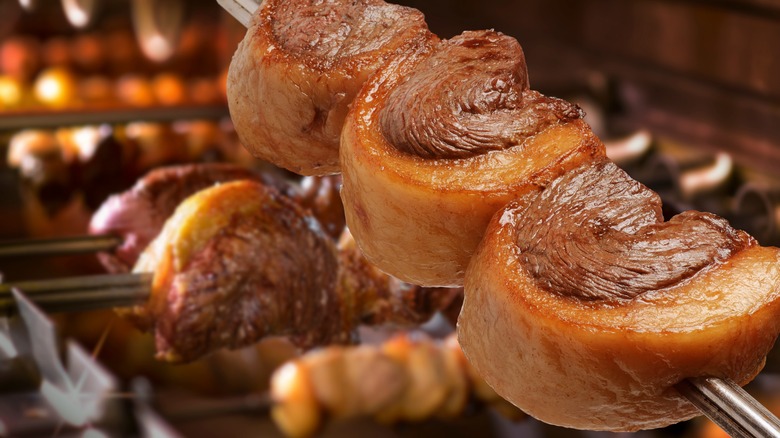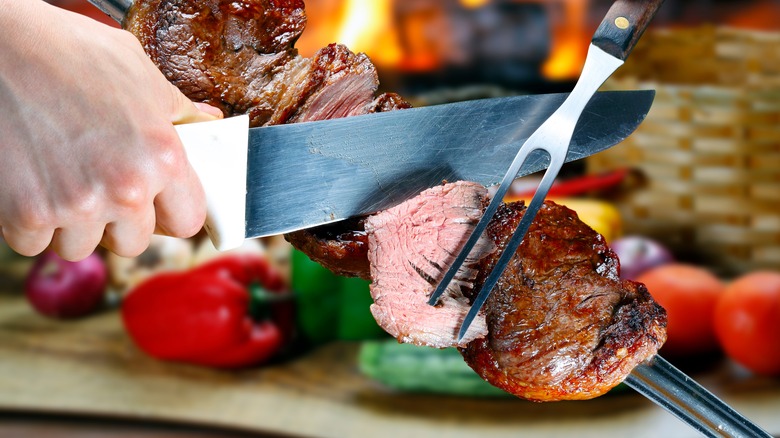Fogo De Chao: 12 Facts About Its Signature Steak
Since its humble beginnings in 1979, Fogo de Chao has become well-known for churrasco, a Brazilian barbecue method that cooks meat on a spit over open flames. The restaurant's website explains that the chain originated in Southern Brazil and expanded into the U.S. in 1997. It was the brainchild of a pair of brothers who grew up on a farm in the mountains. Like most Brazilian steakhouses, Fogo de Chao offers various types of meat for diners to enjoy, such as filet mignon, beef ribs, New York strip steaks, lamb, and chicken. However, the chain's most beloved offering is its signature picanha, a common choice for churrasco-style cooking in Brazil.
According to Steak School, the picanha is an underutilized muscle on the cow's rump, which is very tender because of its location. A high-quality picanha roast is generally small because it sits close to several other cuts. Furthermore, it features a generous fat cap that imparts flavor and moisture as the meat cooks. Picanha is unique and versatile and has a deep beefy flavor that requires minimal enhancement. Not only is this steak delicious, but — like the restaurant itself — it has a rich history behind its origins and has built a loyal following among diners.
A farming tool may have inspired the name
Cattle farming is a time-honored tradition in many parts of the world, and the Portuguese name for Fogo de Chao's signature steak likely has roots in this practice. According to TruBeef, the word "picanha" is likely a derivative of "picana," a pole-shaped prod used by Spanish and Portuguese farmers when tending to herds of cattle. The article further explains that the term made its way to Brazil via colonization in the 1500s. From there, horse riders similar to the American concept of cowboys called gauchos (via Encyclopedia Britannica) adopted the term and continue to use it today.
Of course, terms that have been around for centuries often come with conflicting origin stories. For example, Street Smart Brazil offers another possible explanation for the etymology of picanha. According to the article, the name came from a combination of Argentine-Spanish words related to branding cows with a hot iron. Two of these words, "pica" and "aña," eventually became picanha. Although no one has definitively confirmed the exact origins of the name, one thing is certain. This cut of meat is among the most popular in Brazil, where people widely consider it "The Queen of Steaks" (via TruBeef).
It's a go-to for churrasco
As Gateway to Brazil explains, the churrasco cooking style originated in a southern region of Brazil known as Rio Grande do Sul sometime in the 16th century. The article further explains that gauchos developed churrasco to cook beef with minimal smoke, hoping to preserve the meat's pure flavors. Today, this type of barbecue is at the heart of many social events in Brazil and is an integral part of the country's food culture. Consumers can even purchase a churrasqueria, a unique grill that makes it easy to cook churrasco-style dishes on skewers at home.
Picanha is one of Brazil's most common meats for churrasco cooking, and people often grill it on skewers in the traditional style. Given its widespread popularity, it's no surprise that picanha remains a staple at many Brazilian steakhouses, including Fogo de Chao. A blog post for Certified Angus Beef highlights why picanha is the perfect choice for churrasco. According to the article, the secret is the "C" shape this cut of meat takes on when skewered. This shape allows the thick fat cap to melt and evenly baste the meat as it cooks, creating a tender, juicy finished product.
Picanha goes by many names
The word "picanha" may be unfamiliar to some U.S. diners, especially because this cut of meat has many other names worldwide. For example, Over The Fire Cooking explains that butchers and grocers in the United States traditionally refer to picanha as the rump cap or sirloin cap. In addition, ButcherBox's blog JustCook notes that many diners refer to picanha as coulotte, which may originate from the French word "culot" meaning "cap." Like the English names, coulotte references the meat's location on the cow, which is right above the rump near a large fat cap.
Unfortunately, the naming confusion doesn't end there. As Steak Revolution describes, U.S. diners may also call this cut of meat the rump cover or top sirloin cap. Furthermore, picanha has several other names across Latin America and other parts of the world. For instance, Panamanians refer to it as "punta de palomilla," while Colombians know it as "punta de anca." This wide array of names may perplex those attempting to buy this cut of meat in stores. However, regardless of which name diners prefer, picanha is characterized by its triangular shape, generous fat-to-lean meat ratio, and tender texture.
Picanha is not easy to find in the U.S.
Fogo de Chao diners who want to recreate the chain's picanha at home may face an unexpected problem. As TruBeef notes, many U.S. consumers will be able to find this cut only at specialty butcher shops rather than local grocery stores. As the article explains, this scarcity is because markets often divide this prized section of the cow into three separate cuts before selling. These pieces include the rump, sirloin, and round, which are much more familiar to U.S. consumers. Furthermore, U.S. butchers typically over-trim the fat cap that gives picanha its signature flavor or remove it entirely.
Luckily, picanha's popularity at Brazilian steakhouses has made it easier to find online. For example, delivery services such as Porter Road and Omaha Steaks sometimes sell picanha under its more recognizable Americanized names, such as top sirloin cap. However, ordering picanha from online meat distributors doesn't guarantee that it will have the preferred fat ratio or that it has been cut as desired. Outside of visiting a local Fogo de Chao or other Brazilian steakhouse, diners with a Brazilian meat market in their area will likely have the best luck finding authentic picanha in the United States.
Picanha is also delicious smoked
Although Fogo de Chao gauchos prepare picanha in the traditional churrasco style, this cut of meat also lends itself to other cooking methods. According to Over The Fire Cooking, smoking this cut of beef allows the prized fat cap to melt slowly, creating a delicious, intense flavor. Smoking won't mimic the signature taste of a Fogo de Chao picanha, but it gives diners a new way to enjoy this unique steak. The article recommends slowly smoking the beef for about two hours and topping it with chimichurri, an herbaceous condiment commonly enjoyed in Argentinian cuisine. Traditional chimichurri sauce includes parsley, oregano, garlic, and other common seasonings.
Instead of cutting the meat into steaks, the host from How to BBQ Right demonstrated on YouTube how he smoked a whole picanha roast with a Texas-style dry rub. After resting the roast, the pitmaster sliced into it and taste-tested his creation. His priceless, positive reaction demonstrates how tasty picanha can be when cooked in this manner. Comments on the video echo the host's love for this cut of meat, with several calling it their favorite. One user noted that well-prepared picanha is truly magical, and another stated that the cooked fat cap's crispness enhances the smoked meat's flavor.
Fogo de Chao uses top-rated meat
Any type of beef can be delicious if adequately prepared, but the grade of meat a restaurant uses affects the quality of its dishes. According to the U.S. Department of Agriculture website, the agency divides beef into various grades, with the three best being Prime, Choice, and Select. Beef receives grades based on factors such as tenderness, fat marbling, and flavor. The USDA further explains that Prime beef has the most significant amount of fat marbling, which makes it the juiciest option. However, Choice beef still has plenty of marbling to produce a tasty steak or roast. By comparison, Select meat is far leaner, and some cuts need extra preparation to make them tender, such as marinating before cooking.
In a Mashed exclusive, Fogo de Chao's Southeast Area Director Rudimar Bonfada and a Fort Lauderdale, Florida, location's general manager, Wandering Oliveira, both assert that the chain only uses USDA Choice beef — or better. This dedication to quality means that diners can consistently enjoy tender, juicy picanha at any of the chain's locations. The restaurant's beef grade of choice is also one of the most flavorful options available, which is why its signature picanha only needs simple seasonings.
Picanha is popular with Fogo de Chao diners
Picanha is the signature steak of Fogo de Chao because of tradition, but its popularity with diners also plays a significant role in its status as a menu staple. Just as diners in Brazil have loved picanha for centuries, U.S. diners seemingly can't get enough of this particular cut of meat and aren't afraid to share their opinions on social media. For example, in a Reddit thread about the chain's best meat options, several users list picanha as one of their go-to selections. However, this is just one of many instances of diners giving the restaurant's picanha glowing reviews online. Several Foursquare reviewers for the chain's Boston location also include picanha in their recommendations for must-try menu items.
Diners have also taken to Tripadvisor to praise the picanha at Fogo de Chao restaurants across the country. For instance, one reviewer praised the chain's picanha at the Washington, D.C., location, describing it as their family's meat of choice. A particularly enthusiastic fan in California left a glowing review entitled "Picanha is the best!" This reviewer described the picanha as the biggest highlight on the chain's menu and the top reason they'd dine at Fogo de Chao again.
Coarse salt is a must
There are countless ways to marinate or season steaks, but simplicity is best when it comes to picanha. The meat guide for Fogo de Chao explains that the restaurant seasons its signature picanha only with sea salt or garlic, minimally enhancing the steak's natural flavors. In the exclusive with Mashed, Rudimar Bonfada explains that properly salting meat is part of the gaucho training process at Fogo de Chao since this technique is integral to the steak's signature deliciousness. In addition, Bonfada shares that many diners are surprised by how little seasoning picanha needs because its flavors seem so complex.
This straightforward method of seasoning honors the traditions of the 16th-century Brazilian gauchos, who also chose to season their churrasco meats only with coarse salt before grilling (via Gateway To Brazil). Furthermore, picanha recipes across the internet also employ this simple seasoning practice. For example, Steak School explains that picanha only needs coarse salt because of its intense, pure taste. Unlike traditional, finely ground table salt, coarser salt varieties dissolve more slowly, making over-seasoning less likely during cooking. Coarse salt also adds a light crust to the steak, which improves the exterior texture.
Sous vide cooking adds tenderness
Picanha is well-recognized for its tenderness, but sous vide cooking can make these steaks even juicier. One Reddit user dedicated a thread to sous vide picanha and shared their tips for creating a perfect steak. The original poster seasoned the picanha with salt, garlic, and black pepper before cooking it in a water bath for several hours. To achieve a crust on the outside, they recommend adding coarse salt and flame-searing the picanha on all sides after thoroughly drying it. One user asked about the texture of the finished product, and the original poster explained that this cooking method makes the steak exceptionally tender.
Many other picanha fans and steak experts also consider sous vide an excellent grilling alternative. For example, Chicago Steak Company shared a detailed recipe for sous vide picanha that included a chart to help home cooks achieve the desired temperature for their steaks. In addition, the article notes that sous vide cooking requires far less hands-on work than grilling, making it more appealing to some cooks. However, Fogo de Chao diners who especially love the char of a picanha prepared in the churrasco style will likely miss that with sous vide steak.
Home cooks can also pan-sear it
No other cooking method can capture the same magic as churrasco at Brazilian steakhouses, but fans of the cut have another option for enjoying a tasty picanha at home. Instead of traditional grilling, Chicago Steak Company recommends using a cast-iron skillet to pan-sear picanha steaks in olive oil and butter. TruBeef also suggests pan searing as a suitable grilling alternative, recommending that home cooks sear the fat cap first to begin rendering it. The article suggests using ghee, butter, or even tallow to fry the picanha and also asserts that a cast-iron pan is best for this application.
Pan searing is a relatively common way to cook steaks of all kinds, and the fat content of picanha lends itself well to this preparation. Many experts suggest using cast-iron skillets for cooking picanha and other steaks because these pans offer superior heat conduction compared with most other options (via Mashed). This means higher cooking temperatures, which help create the sought-after hard sear on the outside of steaks. Although pan-searing steak isn't foolproof, it may be a more straightforward method for home cooks who don't have access to a grill or lack experience with grilling meats.
Fogo de Chao has shared its recipes
Many U.S. diners are new to the world of Brazilian churrasco when they first step inside a Fogo de Chao but quickly fall in love with this cuisine. In the spirit of inspiring its diners to try Brazilian-style dishes at home, the chain includes recipes for multiple restaurant favorites on its website. For enthusiasts of the restaurant's signature offering, the recipe for Picanha Con Alho is especially worth trying. The word "alho" means "garlic" in Portuguese and refers to the simple marinade used in this recipe. The marinade combines garlic, olive oil, and sea salt in a blender. In addition, the recipe includes instructions for properly cutting, marinating, and skewer-grilling the picanha.
However, for those who prefer an even simpler flavor profile, the brand offers its most basic picanha recipe. This recipe starts with a whole picanha roast, seasoned with sea salt and hand-cut into steaks. This option most closely mimics how gauchos season picanha in the chain's restaurants. The recipe recommends bringing the steaks to room temperature for 20 minutes before cooking and doesn't specifically require skewering the meat. The chain suggests serving chimichurri sauce with this steak, which would provide a refreshing balance to the picanha's deep beefy flavor.
Diners can bring the restaurant experience home
The unique atmosphere at Fogo de Chao and other Brazilian steakhouses sets them apart from many different dining options in the United States. Fogo de Chao servers carve fresh meat table side, and diners can enjoy as many options as they desire. Although this environment is difficult to recreate at home, diners can still enjoy their favorite meals — including picanha — in between restaurant reservations. One of the simplest options is to order from the Fogo de Chao to-go menu, where consumers will find all of the brand's signature meats, sides, and desserts.
For those who want to get more creative, however, QVC offers a meal kit inspired by the chain's churrasco cooking style. The simple kit includes eight picanha steaks, skewers, and the Fogo de Chao picanha seasoning of choice: rock salt. Home cooks can use this kit to skewer-grill their picanha steaks in the restaurant's classic "C" shape. If this kit isn't inclusive enough, the restaurant chain also offers an online Butcher Shop where consumers can choose from even more Fogo de Chao classics to pick up and cook at home. According to the website, restaurant gauchos prepare the picanha and other items fresh daily, so this option provides the most authentic at-home Fogo de Chao experience in terms of food quality.
